Claire Stevens's Blog, page 64
March 25, 2015
None of the Above by I. W. Gregorio
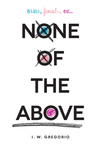 I received a copy of None of the Above in exchange for an honest review. Many thanks to HarperCollins and Edelweiss.
I received a copy of None of the Above in exchange for an honest review. Many thanks to HarperCollins and Edelweiss.Kristen Lattimer is a high school student who seems to have everything going for her. She has a boyfriend who she loves, she’s a champion hurdler with a full scholarship and she’s just been voted Homecoming Queen. But when she decides to take things further with her boyfriend, the whole experience goes horribly wrong and when she visits the doctor she is diagnosed with AIS (Androgen Insufficiency Syndrome): genetically she is male, although her outward appearance is female. Instead of ovaries and a uterus, she has internal testicles and she will never get her period or bear children.
I liked Kristen a lot and I felt her reactions to her diagnosis were very real. She freaks out, she hides away, she denies what’s happening to her and she gets depressed and then gradually she turns things around and begins to accept her diagnosis. The supporting characters were very well written. Their reactions to Kristen’s diagnosis ranged from outright bullying to anger to acceptance. I wasn’t a fan of Kristen’s boyfriend, Sam, especially after his reaction to her being intersex but I was glad there were characters who were accepting of Kristen’s diagnosis to balance out the bullies.
None of the Above is about what it means to be intersex (what used to be called hermaphrodite), but it’s also a story about friendship, relationships, bullying and tolerance, about what it means to love someone for who they are, not what they are. It also does a great job of setting out the differences between and showing examples of sex, gender and sexuality - distinctions that still get confused. It’s definitely a story that will make you ask questions about yourself and what your reactions would be if you or someone you knew was diagnosed intersex.
The language in the book is slightly clinical at times; there were a few passages that made me wince slightly and jam my knees together and I’ve gotta say, I’m hoping the next book I read doesn’t mention speculums too much! This is really just a minor point though, because in all other respects None of the Above is an incredibly important book bringing some much-needed diversity to YA literature.
9/10
Published on March 25, 2015 04:37
March 24, 2015
Made For You by Melissa Marr
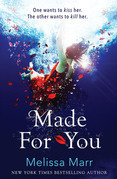 I was given a copy of Made For You in exchange for an honest review. Many thanks to HarperCollins and Netgalley.
I was given a copy of Made For You in exchange for an honest review. Many thanks to HarperCollins and Netgalley.First I want to start by saying how much I enjoyed this book. It’s a murder mystery with a bit of psychic phenomena thrown in and the author absolutely piles on the creep factor, keeping you guessing right to the final revelation. It’s incredibly readable and there were points where I found myself going, ‘Just one more page, just one more page’.
When Eva Tilling wakes up in hospital after a hit and run accident she thinks her main problem is going to be getting used to the scars on her face and the months of physical therapy to recover from her broken leg. When the police investigating the incident tell her it may not have been an accident after all, she is shocked, but then when she discovers that her head injury may have awoken a latent psychic ability, things start to get really crazy. Little does Eva know that the killer’s work isn’t over yet...
The story is written from the viewpoint of three characters: Eva, her best friend Grace and the killer, someone who refers to themselves as ‘Judge’. Hearing what the crazy murderer was thinking and their twisted rationale definitely added to the creep factor.
When the book started I wasn’t sure how much I’d be able to identify with Eva. Her family are well-off and own half the town they live in. Everyone in town watches her and everyone at school looks up to her, and pre-murder-attempt, her problems literally seem to be limited to those of the ‘My Diamond Shoes Are Too Tight’ variety. Coming from a super-rich family and being judged purely on my astonishingly pretty looks is, sadly, not a problem I’ve ever had to contend with, but as the story progressed I found myself liking her more and more. I think this is the sign of a good writer. It’s easy to identify with the outcast, the shy girl, the characters with flaws. It’s harder to identify with the queen bee.
Eva doesn’t seem to have that filter that stops you blurting out inappropriate things, which was quite amusing at times. I also liked the way she tried to protect the people who were at risk of being murdered, although some of her decisions were a bit rash.
The setting of the book is North Carolina and although the book has a southern feel to it, the author doesn’t fall into the trap of relying on run-down plantation mansions out in the middle of nowhere with vines and creepers everywhere to make her story spooky.
I read Wicked Lovely, also by Melissa Marr, a while back and Made For You has reminded me what a great writer she is.
8.5/10
Published on March 24, 2015 07:26
March 23, 2015
Persepolis by Marjane Satrapi
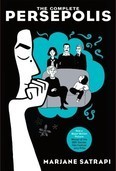 This was a book club book, but it was my choice, so therefore it was awesome as opposed to sucky beyond all comprehension (see my review of Therese Raquin).
This was a book club book, but it was my choice, so therefore it was awesome as opposed to sucky beyond all comprehension (see my review of Therese Raquin).Persepolis is the graphic novel autobiography of Marjane Satrape. Born in Iran in 1969, Persepolis is the story of her childhood in Iran and later Europe. Her middle-class parents were politically active against the monarchy of the Shah. After the fall of the Shah, they suffered intimidation by the Muslim fundamentalists who took power.
During her childhood and teenage years, Satrapi witnessed police brutality, persecution, arrests of people she loved and even murder. Concerned that the rebellious Marjane would run into trouble as a result of the new stringent rules for women and girls, they arranged for her to go and study in Europe during her teenage years.
If you only ever read one graphic novel, it needs to be this one. Seriously.
The characters in Persepolis are shown with all their faults. The author doesn’t sugar-coat anything. Marjane herself as a child is precocious and as a teenager she can be obnoxious and outspoken. To write your autobiography and not either paint yourself as a total Mary-Sue, or try to cover up your poor decisions or explain them away takes a lot of guts, I think.
I think what makes Persepolis so engaging is that although it’s a fascinating historical, social and political commentary, it’s told through the eyes of a child and then a teenager, so it never falls into dreariness. You see what actually happened in Satrape’s life and how it was shaped by the political mood of her home country. It is in turn heartbreaking and heartwarming but is also brutally honest and opens your eyes to the way other people live. It’s one of those rare books that genuinely changes the way you see your own life and that of other people.
10/10
Published on March 23, 2015 05:10
March 22, 2015
Chaos by Sarah Fine
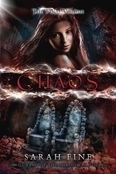 Chaos is the third instalment in the Guards of the Shadowlands series. I read the first two books, Sanctum and Fractured, last year and was really looking forward to the conclusion.
Chaos is the third instalment in the Guards of the Shadowlands series. I read the first two books, Sanctum and Fractured, last year and was really looking forward to the conclusion.At the end of Fractured, everything seemed to have gone a bit wrong for poor old Lela and her companions. The mazikin had broken through to the mortal realm and were busy terrorizing everyone; people were killed, Malachi was possessed and it was just a big old mess. I got to the last page and had one of those ‘Nooooo!’ moments, so I was really excited to read Chaos.
Unfortunately, Chaos just seemed to fall a bit flat for me. Looking at some other reviews, I get the impression that this is a bit of a minority opinion, but the storyline just didn’t draw me in like the other two books did and I found it hard to keep my concentration. The action scenes, of which there are plenty, felt a bit jumbled. It was also quite a long book and I thought that by cutting it down a bit it would have sharpened the plot up and increased the tension.
There were still aspects which I enjoyed: Lela is an awesome MC, really gung-ho and not one of these little ‘Save me, save me’ girls who rely on the boys to do all the fighting. I also liked the way you never really knew who was a friend and who was an enemy - it gave the plot a nicely nightmarish quality. And I was glad Lela and Malachi got their happy ending!
Possibly I’ll go back to the Guards of the Shadowlands series at some point in the future - Sanctum and Fractured have a lot of re-read potential - and hopefully Chaos will work better second time round.
6/10
Published on March 22, 2015 03:13
March 20, 2015
Everything Everything by Nicola Yoon
 I received a copy of Everything Everything in exchange for an honest review. Many thanks to Penguin Random House UK and Netgalley.
I received a copy of Everything Everything in exchange for an honest review. Many thanks to Penguin Random House UK and Netgalley.Oh my word. Where to start.
I started Everything Everything yesterday morning and just couldn't put it down. It was like my Kindle was superglued to my hand. This book reeled me in and just didn’t let me go.
Everything Everything tells the story of Madeleine, an eighteen year old girl with SCID (severe combined immune deficiency). Madeleine is allergic to the outside world and lives in a sealed environment with her mum and her nurse. She lives her life in her little bubble, taking classes online and staying indoors at all costs and she accepts her condition, never considering going outside until a new family move in next door and she meets Olly.
I loved Madeleine. She was as mentally strong as she was physically compromised and managed to pack so much into such a sheltered life. One of the (many) parts that nearly had me in tears was where she spent her eighteenth birthday eating vanilla cake and being beaten at Scrabble by her mum. And Olly was so adorable and cared so much about Madeleine even though he had his own problems.
The plot kept me guessing throughout. At times I thought I could see where it was going, but then it surprised me and took a different direction altogether and was touching, funny, sweet and so, so sad.
I think there will be inevitable comparisons with The Fault In Our Stars and while there are similarities (girl lives constrained life due to medical condition before meeting boy and falling in love). I don’t want to add any spoilers to my review, but in fact the two books are actually pretty different.
Nicola Yoon has created such a wonderful book with Everything Everything; I think she’ll be one to watch out for in the future.
9.5/10
Published on March 20, 2015 02:02
March 19, 2015
Mary Hades by Sarah Dalton
 I received a copy of Mary Hades in exchange for an honest review. Many thanks to the author, Sarah Dalton, and Netgalley.
I received a copy of Mary Hades in exchange for an honest review. Many thanks to the author, Sarah Dalton, and Netgalley.It's not often I go for a ghost story, but something about the blurb of Mary Hades drew me in and I'm really glad it did! It's the story of a girl, Mary Hades, who sees ghosts. Her parents think it's a psychological problem and Mary pretends to take the medication her doctors give her, but she knows the ghosts she sees are real. All this is fine until Mary and her parents go on holiday to a caravan site haunted by a ghost who's recently stated to get a bit violent....
Mary Hades is written like a proper old-fashioned ghost story, in a kind of 'bad ghost versus protagonist whose job it is to defeat it' way. I thought it was a great story with likeable characters and a plot that kept me reading all the way through. There's a bit of romance, but it doesn't overwhelm the action. It's also kind of Scooby-Doo (in a good way): Mary has her gang of buddies and they set about trying to solve the mystery of why this ghost has been killing people. Spoiler alert: the ghost in Mary Hades didn't turn out to be the caretaker from the haunted amusement arcade.
9/10
Published on March 19, 2015 04:40
March 17, 2015
The Death House by Sarah Pinborough
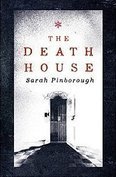 The Death House tells the story of Toby, one of a group of children who has been identified as having the Defective gene after a routine blood test. He now lives at The Death House, an isolated mansion on an island in the North Sea with others like him, where they are studied by Matron and her team of nurses for signs of sickness. If you get sick, you’re taken upstairs to the sanatorium. And no one ever comes back from the sanatorium.
The Death House tells the story of Toby, one of a group of children who has been identified as having the Defective gene after a routine blood test. He now lives at The Death House, an isolated mansion on an island in the North Sea with others like him, where they are studied by Matron and her team of nurses for signs of sickness. If you get sick, you’re taken upstairs to the sanatorium. And no one ever comes back from the sanatorium.First off, I have to say that I did enjoy the Death House. It was a really interesting premise and the plot went into a lot of detail about what would happen with a group of kids, mainly boys, who were lumped together in an isolated house just to wait to get sick and be carted off to an unknown (but presumably grisly) fate.
I really liked Toby. It was good to see a main character with faults (he doesn’t pretend to be brave about his fate and he’s kind of immature in his attitude to girls) but who also has a lot of excellent qualities. The other characters also have a mixture of good and bad qualities and it was interesting to see how they all dealt with and anticipated their fates.
Matron and her nurses flit in and out like ghosts, barely interacting with the children and leaving them to their own devices for much of the time, which allowed us to see
The problem I had was that I wasn't really sure what the book was trying to do. A creepy, isolated house on an island in the middle of nowhere where children are sent to die has the potential to be super frightening and this book could have been an amazing YA horror story, but most of the story was taken up with Toby and Clara's relationship and the tension and petty squabbles between the dormitories. Don't get me wrong - this was fine and it was still interesting to read, but it wasn't scary or tense, it read more like a high school drama. Going by the cover art (and yes, I do judge a book by its cover) and the blurb, I was expecting some kind of Blair Witch meets Lord of the Flies.
I was also confused about the nature of the Defects the kids were supposed to have. It was alluded to a couple of times that their defective genes would cause them to turn into monsters and that these monsters had somehow nearly brought about an apocalypse before testing for the Defective gene was introduced, but we’re never told exactly what happens when the Defective gene matures, or what happened before. I get that mystery keeps it tense and that infodumps are A Bad Thing, but I actually ended up feeling robbed. Instead we got a lot of background into Toby’s past with his parents and the girl he used to fancy. This was interesting, but didn’t really move the plot along.
A lot of questions remained unanswered at the end. Who was Matron really? What happened to the teachers and nurses? Why, when the Defective gene is identified, are children not just euthanized at The Death House instead of waiting for them to get sick?
Despite this, I still thought The Death House was an interesting story. It just didn’t have the Creep Factor I was expecting.
6/10
Published on March 17, 2015 07:05
March 14, 2015
Six of Hearts by LH Cosway
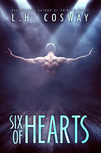 Okay, I can’t remember who recommended Six of Hearts to me, but when I do I’m going to buy her (it was almost certainly a her) a drink!
Okay, I can’t remember who recommended Six of Hearts to me, but when I do I’m going to buy her (it was almost certainly a her) a drink!Six of Hearts is narrated by Matilda, a lovely but socially awkward girl who works with her dad as his legal secretary. Her mother was killed by burglars when she was eight (boo), and she and her dad live a quiet, unspectacular life in Dublin, dealing with the immense sadness of their past. Then, just as she’s checking her online dating status, Jay Fields walks into her office. Jay convinces Matilda’s dad to take on a defamation case he wants to bring against one of Ireland’s top newspapers and everything in Matilda’s quiet world kind of gets turned upside down.
Now, I’m not sure why, but I went into this thinking it would be a YA book. It became apparent fairly early on that it’s not a young adult book. The reason for this is there’s some pretty serious action. And not the car-chase sort of action, either. ‘Rude,’ I found myself tutting, as I bookmarked the pages on my Kindle for future reference. Having said this, even though the sex is quite graphic, it’s nice sex. You know, with feelings and shit.
And the story is good too. Probably should have mentioned that first. The plot is good and pacey with never a dull moment (especially when you know that things are going to break out into spontaneous sex at any moment). It’s part romance, part mystery/suspense, part revenge story.
The characters are lovely, too. Matilda is just such a great protagonist; so sweet, but with a nice sarky side as well.
And Jay. Sigh. I know that the whole ‘socially awkward girl and desperately attractive man with a shady past’ has been done like a billion times, but I don’t care. It was fun and it was escapism. And I may have found myself having impure thoughts about Jay as I made the breakfast this morning.
Now excuse me, I just have some passages to go back and re-read.
8/10
Published on March 14, 2015 08:19
March 12, 2015
Bomb by Sarah Mussi
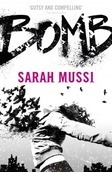 I received a copy of Bomb in exchange for an honest review. Many thanks to Hodder Childrens Books and Netgalley.
I received a copy of Bomb in exchange for an honest review. Many thanks to Hodder Childrens Books and Netgalley.The last couple of books I’ve read have been sadly lacking in action and have left me worrying that I was about to hit a reading slump, so it was with trepidation that I picked up Bomb.
By the time I’d finished the first chapter, however, I realised that my fears had come to nothing. I don’t put gifs in my reviews, mainly because I haven’t figured out how to, but if I did use gifs, I’d probably use one of Turk from Scrubs doing the Cabbage Patch Dance. Yay! Bomb is a book where something happens.
No, scratch that out. Bomb is a book where LOADS happens.
Bomb, or Why You Should Never Ever Ever Go On A Blind Date, tells the story of Genesis Wainwright, a teenage girl who, heartbroken by being dumped by her boyfriend Naz, meets a guy online and goes on a blind date. The story starts with Genesis waking up in a damp cellar after the blind date, superglued into a corset stuffed with huge amounts of C4 and an earpiece in her ear with a creepy voice telling her where to go and what to do. After a few understandable moments of freaking the hell out about finding herself to be an unwitting suicide bomber, she complies and starts doing what they tell her...
There was a point a few chapters in where I wondered where the plot was going and how the author was going to spin out Genesis wandering around doing what she was told for a whole book, but I didn’t need to worry, because in walks Dave.
Aah...Dave. Nice Dave. Dave is Genesis’s ex-boyfriend, the one she dumped for Naz (more about Naz later). I liked Dave but I was glad that Bomb didn’t basically turn out to be How Genesis Got Her Ex-Boyfriend Back, i.e. the romance didn’t overwhelm the action. He did seem to be constructed out of purest plotdevicium (he walks back into her life at the exact point when Genesis needs a bomb disposal expert, and it just so happens...he’s a bomb disposal expert! Yay!) but did I care? Not a jot. Bomb relied on some CSI-like leaps of logic and lucky coincidences, and in the nicest possible way, I would say it is a lot like Die Hard 3. It has car chases, motorbike chases, police-dodging, helicopters, the whole shebang.
In addition to the action, Bomb deals with issues surrounding radical, extremist groups and what motivates people to join them, to commit unspeakable acts of violence against other humans, and with daily reports of people leaving the UK to join up with ISIS I guess it’s pretty relevant.
The cult who have turned Genesis into a suicide bomber are The Brightness, a religious extremist group (the actual religion they are an extension of is left suitably vague) who want to bring about the End of Days and while disaffected people have always been easy targets for extremist groups, it did confuse me slightly how mainstream The Brightness seemed to be. They had adverts on the side of buses and their own range of fashion wear. Not tactics I think ISIS have ever employed. And while we’re told why Naz joined them, it’s never really explained how they became so mainstream.
So. Naz. This is the one part that I felt Bomb fell down a bit. When it emerges that Genesis has been recently dumped, I started off thinking, ‘Aw, poor thing. All heartbroken.’ But then it’s revealed that her ex-boyfriend:
1) Joined a cult who despise women and condone acts of extreme violence
2) Asked her to shave her head and get his name tattooed on her scalp
3) Shot swans with an airgun in his spare time.
Swans! Seriously? I mean, cults and misogyny and head tattoos and stuff equals bad, obviously, but SWANS? What the hell did swans do? And why did Genesis never turn round to him and go, ‘You’re shooting SWANS! What the HELL?’ Anyone who would fall in love with someone who shoots swans loses something as a protagonist, in my opinion.
And I get that Genesis being drawn into a relationship with this unsavoury, swan-shooting youth is a metaphor for him being drawn into this extremist cult, but still. Swans!
Still, Evil Meany Naz and Genesis’s Poor Decision-Making Skills aside, I did enjoy Bomb. The tension starts up on the very first page and does not let up until the final sentence.
8/10
Published on March 12, 2015 16:33
March 10, 2015
Never Let Me Go by Kazuo Ishiguro
 Okay, so it’s fair to say that my area of choice when it comes to books is young adult, but despite Never Let Me Go being literary fiction (it was nominated for a Booker prize) I decided to give it a go because it was going cheap on Amazon, it’s about young adults and it’s also a bit speculative fiction in that it deals with alternate Britain where cloning humans for organ harvest was introduced in the 1950’s. So far, so interesting.
Okay, so it’s fair to say that my area of choice when it comes to books is young adult, but despite Never Let Me Go being literary fiction (it was nominated for a Booker prize) I decided to give it a go because it was going cheap on Amazon, it’s about young adults and it’s also a bit speculative fiction in that it deals with alternate Britain where cloning humans for organ harvest was introduced in the 1950’s. So far, so interesting.I try, wherever possible, to keep my reviews as positive as I can. I feel the world has enough negativity sloshing around without me adding to it. I’m really struggling to find anything positive to say about this book, though.
Never Let Me Go is narrated by Kathy, a girl who grew up in a children’s home in the 1980’s (I think). Kathy and all the other children she lived with are clones. They were created with the idea that when they reach their twenties, they will start ‘donating’ their organs and will continue doing so until they die.
Kazuo’s writing style in this book is very conversational. It’s as if Kathy is dictating her memoirs to someone she has met in a coffee shop. Kathy’s chattiness is interesting, but she goes off on complete tangents an awful lot, telling the reader a story about something seemingly random. Then she goes back to the original point she was making, except that she’s been rambling off on her tangent for so long you can’t remember what the original point actually was.
This brings me on to the plot. Oh my, the plot. I think Never Let Me Go is kind of a concept book - the underlying concept being ‘how we remain human under inhumane conditions’. I think. I get that concept books don’t necessarily have to have masses of action and be really plot-driven, but I would still expect something to happen. Most of the book seems to be a collection of boarding school/children’s home anecdotes and the children don’t seem any different from non-clone children: they play, they learn, they squabble. When they reach their teens, they think about sex. If this is the author’s point, then I think he could have said it in a lot fewer than 300 pages.
When the children are old enough to leave their home/school, they go and live in a sort of sheltered accommodation place - some cottages on a farm. Again, nothing happens. They mooch around, read, go for walks, have sex with each other. They don’t even really seem to speculate about their impending donations (which you would think would be at the forefront of their minds).
Because the characters in this book are clones, there is naturally some speculation as to who their ‘original’ is. But this just seems to be another area where nothing really happens. At one point, someone thinks they may have found Kathy’s ‘original’, so they drive up to Norfolk to check it out. It isn’t her. They squabble. Then they come home again.
I think part of the problem is that I’ve read so many books recently where the author has had an interesting idea and has extrapolated it out, investigating the ‘What Would Happen If...’ aspects interestingly and intelligently, that I just feel a bit robbed when the author starts with an idea that has so much potential and just meanders around before stopping.
Okay, now for the characters. They were deeply unlikeable. Tommy was a drip, Kathy was po-faced and Ruth was a spoilt brat. Maybe their negative characteristics were supposed to be a result of their inhumane treatment? Who knows? Not me. All I know is that a book that is neither plot-driven nor character-driven tends to go nowhere and does it at a very slow pace.
Trying to think of a rating for this book is really difficult. It might well be that I’m just not ‘getting’ it, that there are layers of sub-plot and metaphors and social commentary that I’ve not seen, but at the end of the day all I can do is rate it on how much I liked it.
2/10
Published on March 10, 2015 06:46
Claire Stevens's Blog
- Claire Stevens's profile
- 41 followers
Claire Stevens isn't a Goodreads Author
(yet),
but they
do have a blog,
so here are some recent posts imported from
their feed.



